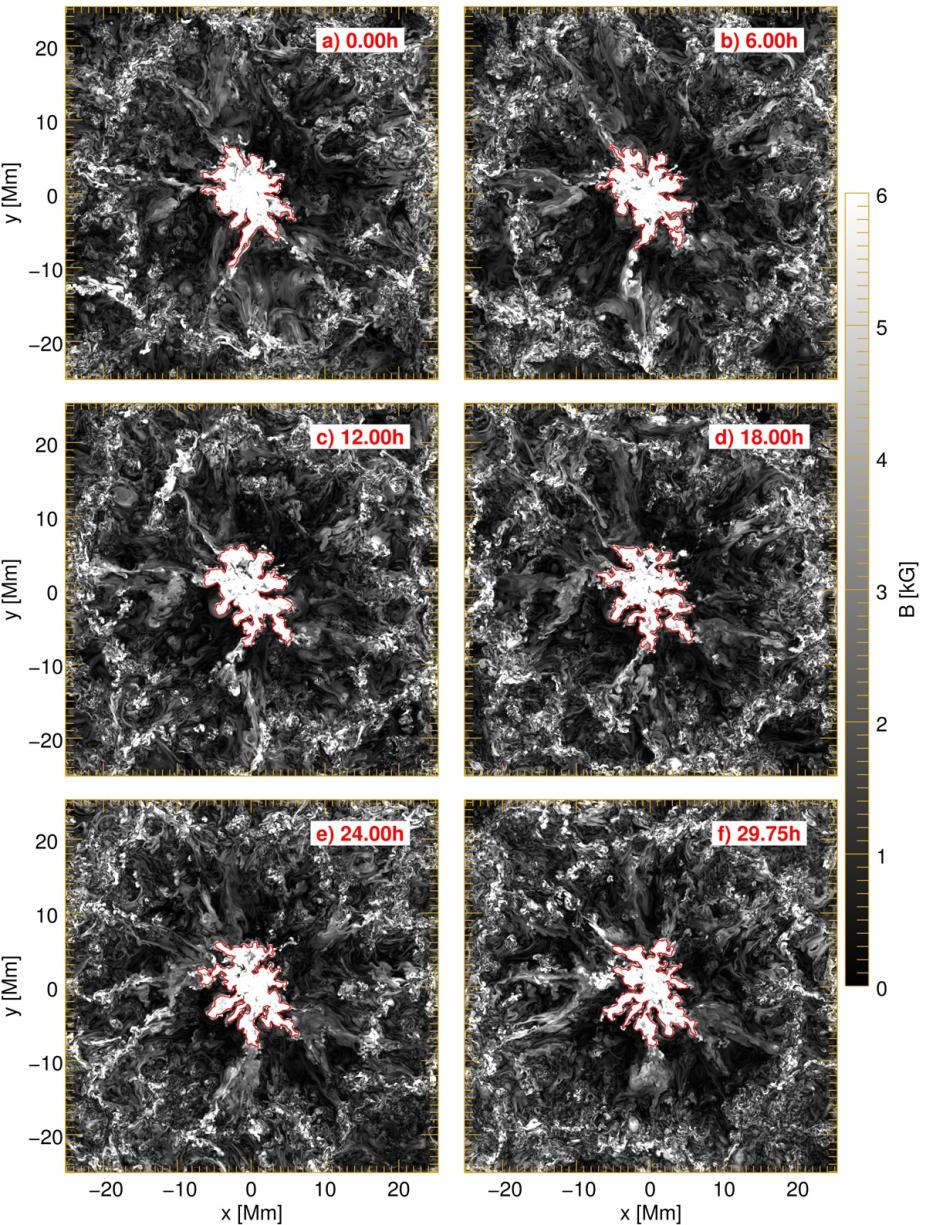Publication: Astronomy & Astrophysics; Authors: H. Strecker, W. Schmidt, R. Schlichenmaier, M. Rempel
The stability of sunspots is one of the long-standing unsolved puzzles in the field of solar magnetism and the solar cycle. The thermal and magnetic structure of the sunspot beneath the solar surface is not accessible through observations, thus processes in these regions that contribute to the decay of sunspots can only be studied through theoretical and numerical studies.
Aims: We study the effects that destabilise and stabilise the flux tube of a simulated sunspot in the upper convection zone. The depth-varying effects of fluting instability, buoyancy forces, and timescales on the flux tube are analysed.

Maps of the magnetic field strength at depth of z = −7.5 Mm beneath the solar photosphere at different times (indicated in red in each panel). The boundary of the sunspot (red line) is defined by the contour value Bc = 4781 G. At the beginning of the analysis, at t = 0 h, panel (a), the inner part of the flux tube is mainly undisturbed. Within 6 hours, regions of weaker field appear in the innermost part of the flux tube while the outer structure becomes more ragged, as is shown in panel (b). The increasing raggedness causes a degradation of the flux tube. This degradation process continues in time, as panels (c–e) show. At 29.75 h, the roundish structure of the flux tube has completely vanished. The degradation process takes place in all regions deeper than 1 Mm below the surface.
Methods: We analysed a numerical simulation of a sunspot calculated with the MURaM code. The simulation domain has a lateral extension of more than 98 Mm × 98 Mm and extends almost 18 Mm below the solar surface. The analysed data set of 30 hours shows a stable sunspot at the solar surface. We studied the evolution of the flux tube at defined horizontal layers (1) by means of the relative change in perimeter and area, that is, its compactness; and (2) with a linear stability analysis.
Results: The simulation shows a corrugation along the perimeter of the flux tube (sunspot) that proceeds fastest at a depth of about 8 Mm below the solar surface. Towards the surface and towards deeper layers, the decrease in compactness is damped. From the stability analysis, we find that above a depth of 2 Mm, the sunspot is stabilised by buoyancy forces. The spot is least stable at a depth of about 3 Mm because of the fluting instability. In deeper layers, the flux tube is marginally unstable. The stability of the sunspot at the surface affects the behaviour of the field lines in deeper layers by magnetic tension. Therefore the fluting instability is damped at depths of about 3 Mm, and the decrease in compactness is strongest at a depth of about 8 Mm. The more vertical orientation of the magnetic field and the longer convective timescale lead to slower evolution of the corrugation process in layers deeper than 10 Mm.
Conclusions: The formation of large intrusions of field-free plasma below the surface destabilises the flux tube of the sunspot. This process is not visible at the surface, where the sunspot is stabilised by buoyancy forces. The onset of sunspot decay occurs in deeper layers, while the sunspot still appears stable in the photosphere. The intrusions eventually lead to the disruption and decay of the sunspot.